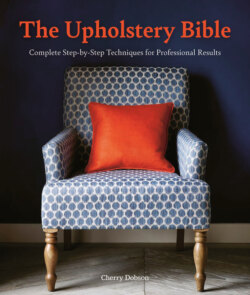Читать книгу The Upholstery Bible - Cherry Dobson - Страница 11
На сайте Литреса книга снята с продажи.
WEBBINGS AND SPRINGS
ОглавлениеWebbing is used as the foundation for furniture. A strong seat requires a strong base, with properly spaced webbing that will even the weight and diameter of the springs used. There are several types of webbing made from jute, linen, cotton or rubber. When reupholstering, use webbing similar to that originally used on the chair. Stretch the webbing across your frame using a webbing stretcher to form a sound base for the subsequent materials. Always use good quality webbing and never reuse the old webbing, which will almost certainly be past its sell-by-date. Springs are an integral part of traditional upholstery, and while not all seating must be sprung, springs do add depth and comfort that you don’t always get with just padding and foam. Your choice of spring will depend on the piece you are upholstering. If you replace springs, use the same type used in the original upholstery.
SPRINGS
1 Coil springs are used in traditional chairs and come in a variety of heights and gauges. The firmer No. 9 or No. 10 springs are used on the seat, and the softer No. 12 springs are used for the backs. The number of springs used depends on the size of the seat. A dining chair, for example, would have four 12.5 cm (5 in.) No. 10 gauge springs, whereas a large armchair would have nine 17 cm or 20 cm (7 in or 8 in.) No. 9 gauge springs.
2 Tension springs are more commonly used on fireside chairs and are fixed with clips or hooked into a webbing or metal plate with eyelet holes. The springs should be stretched across the frame of the chair and measure 2.5 cm (1 in.) less than the width of the frame.
3 Zigzag springs are used for all modern upholstery. They are attached by clips across the frame of the chair from back to front and, for the professional upholsterer, are a quick and easy type of spring to apply.
WEBBING
4 Black and white webbing (with a double chevron weave) is the best quality but also the most expensive. It usually comes in a 5 cm (2 in.) width, and is used on traditional chairs.
5 Jute is the next best alternative to black and white and is the webbing most commonly used.
6 Rubber webbing is used on modern chairs to replace tension or zigzag springs, and to form a base for a seat upholstered with foam or rubberized hair. It is stretched across the chair frame and held in place with either clips or staples.
7 Heavy rubberized elastic webbing is used as an alternative to rubber webbbing.
